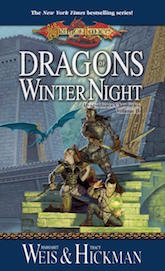The best thing Sturm Brightblade ever did was die.
I did not discover literature of any kind until I was about eleven, or ten. I was, without a sliver of a doubt, a no good, lazy slacker of a child, and after I discovered literature, I was totally and utterly a no good, lazy slacker of a child who read books. A lot of books, good and bad, but my favourite—the books I read and reread in my teens—were by Margaret Weis and Tracy Hickman. Specifically, I had a deep and complete love for the Dragonlance Chronicles. First published in 1984, Dragons of Autumn Twilight began what would be one of the icons of my grunge stained disenchanted childhood. I know it all, back and front, left and right and, thirty years after the first book began the series, I still remember the scenes at the end of Dragons of Winter Night, where Sturm Brightblade slowly and surely, walked to the top of a tower to fight a dragon with little more than the sword his father left him.
He died, of course.
In Dragons of Autumn Twilight, Weis and Hickman presented him as the noble knight, living his life to a code referred to as the Oath and the Measure. It was, as you would suspect, fairly standard fair: don’t lie, don’t back down, try to rescue a woman if she looks vaguely in distress. For all that I love Weis and Hickman’s Chronicles, I will not claim to be immune to their faults as an adult. In their first book, Weis and Hickman did not stray far from the tropes of fantasy and role playing, and you could almost hear the book being read in a gaming sessions, somewhere between Missouri and Utah, wherever the TSR office at the time was kept. At thirty-six and twenty-eight, Weis and Hickman had not intended to become the authors of the series, but had rather been responsible for mapping the project out and managing the author who would write it. They would take control of it because of their own desire—and perhaps ambitions, as well—but it would not be until their second trilogy, Legends, that they would begin to find their feet properly in novels. But for all that, they still managed to make one irritating character out of Sturm Brightblade and his Oath and Measure.
Buy the Book


Dragons of Winter Night (Dragonlance Chronicles, Volume II)
But then, in Dragons of Winter Night, Weis and Hickman stripped him of his knighthood, revealing him as a man who clung to an ideal that was long gone, to a family history that was more a weight than a blessing—
And then he walked up into that tower, to die.
Characters die, all the time. The death of Sturm Brightblade was the first violent death of a character in a book I can remember. In his final moments, it made Sturm likeable. It was the last breath, desperate attempt to help your friends by the sacrifice of your life and, in that one moment, Sturm Brightblade did the best thing his character could possibly do: he died. He left a legacy within the book that, realising that it was not the act of his death that gave it such strength, but rather his mortality, Weis and Hickman let the legacy of his physical failure and demise settle into their world and their writing.
Over the remaining books, the characters who appeared in Dragons of Autumn Twilight would all touch their own mortality. Flint, Tasslehoff, Raistlin, Caramon, Tanis, Goldmoon and Riverwind—each of them would die, though in Riverwind’s case, it would be at the hands of a different author, a violation that felt somehow worse than the event itself when I was young. Indeed, perhaps it was this lack of control over their own characters that also dictated Weis and Hickman’s actions. But if that played a role or not, Weis and Hickman, through sword, age, heroism, kindness, and cruelty led each character to their own mortality. For the last surviving member of the cast, Laurana, Weis and Hickman even return to Sturm’s death, crafting a demise that mirrored Sturm’s at the end the second book in the War of the Souls trilogy.
Thirty years after the initial publication of Dragons of Autumn Twilight, I can honestly say that Weis and Hickman have gone on to write better books in terms of simple craft. The Death Gate Cycle was probably my favourite and, I believe, their best. But the Rose and the Prophet trilogy always felt to me as if it slid under the radar of a lot of people. The Darksword trilogy was always a favourite of other people, though it fell behind the other two for me. There would be a few proper missteps in their career, though. The Sovereign Stone Trilogy was a misfire, oh yes, but it was not the disaster that two Starshield novels were. Nor was the return to the series that made their name always excellent. Despite a fine finale in Dragons of Summer Flame, they returned for a tired War of the Souls trilogy, and a series called the Lost Chronicles, which I suspect, only for die-hards like myself were up for.
But those original books of my youth, no matter their faults to my adult gaze, still resonate strongly in my memories with characters whose mortality was never once forgotten.
This article has been edited since its initial publication in August 2014.
Ben Peek lives in Sydney, Australia with books, a cat, and a photographer named Nik. He has written several books and contributed to many, many anthologies. The novels the Children trilogy—The Godless, Leviathan’s Blood, and The Eternal Kingdom—are available from Tor Books in the US and Thomas Dunne in the UK.










